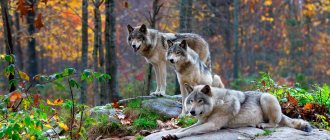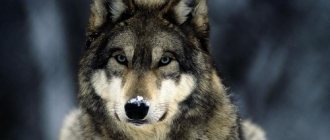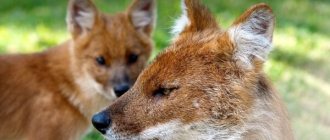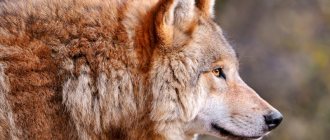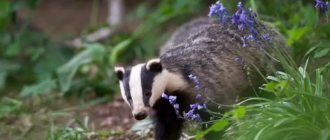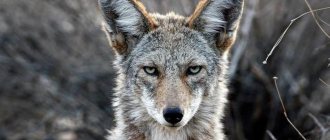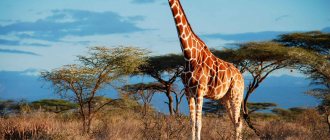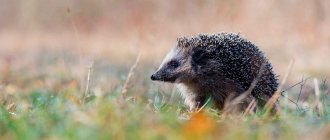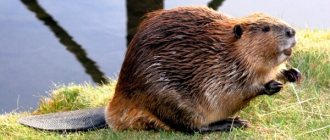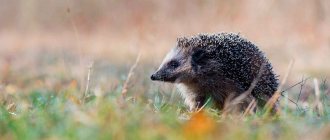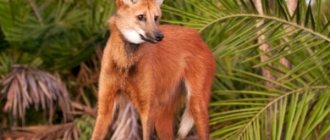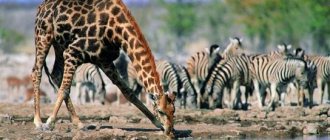22 November 130126canine family predator wolf-dangerous
Everyone remembers the fairy tale about the gray wolf that we were told in childhood. So who exactly is a wolf? An image from a fairy tale or a dangerous animal? The common wolf is a large predator of the Canidae family. The gray wolf is the master of the tundra and taiga, a hardy and very intelligent animal. In this article you will find a description and photo of a wolf and learn a lot of interesting things about the harsh life of this formidable predator.
What does a wolf look like?
Externally, the common gray wolf is very similar to a dog, which is not surprising, because these animals have common ancestors. However, the wolf looks much larger. The body length of a wolf can reach 110-160 cm, the tail length can be up to 52 cm, the height at the withers ranges from 60 to 90 cm, and the body weight of a wild predator can reach up to 80 kg.
There were cases when the weight of individual individuals exceeded 92 kg. The average weight of wolves varies from 30 to 65 kg. The size and weight of wolves depend on geographic location. The colder the climate, the larger the animal. Males are always larger than females.
The wolf animal has thick, rather long and warm fur, which consists of two layers, which makes the wolf look larger. The first layer of the common wolf's fur is tougher and protects against dirt. The second is a waterproof undercoat that protects the wolf from the cold and various extreme conditions of nature. The gray wolf animal is very hardy.
The wolf looks like a threatening and dangerous animal, has a strong muscular body, high strong paws and a large broad-browed head with pointed ears. The elongated and large muzzle with dark stripes is combined with almost white cheeks and light spots in the eye area. The massive muzzle of the wolf is also very expressive. The gray wolf's tail is quite long and usually hangs down. By its movement and position one can judge the mood of the predator.
The common wolf has completely different colors, depending on its habitat. In forests it is a gray-brown color. In the tundra it is lighter, almost white. In the desert – grayish-reddish. There are even white individuals that are found in the Arctic, as well as red or almost black ones. The animal's undercoat is always gray.
How is a wolf different from a dog? The common wolf differs from the dog not only in appearance, but also in its tracks. The track of the gray wolf's tracks is smoother than that of dogs and forms an almost straight line. Also, the wolf has a different track length, which is 9-11 cm, and the width is 6-7 cm; for the she-wolf it is 7-9 cm and 5-6 cm. The two middle fingers of the wolf’s paw are more forward, the fingers are not spread out and form a significantly more prominent print than that of a dog.
Where do wolves live?
The wolf is an animal that is the most common land predator. This wild animal has a wide habitat. The wolf lives mainly in cold countries and in various landscapes. In forests, steppes, deserts, taiga, tundra, forest-steppe and at the foot of the mountains.
Wolves live in many areas of Europe (from Russia to Portugal), Asia (from Korea to Georgia) and North America (from Alaska to Mexico). Large individuals inhabit the tundra, and small ones inhabit the southern regions. It is curious that in Russia the wolf is absent only on the island of Sakhalin.
The common wolf is a territorial animal. Packs of wolves live in conquered areas, the boundaries of which are marked with marks. In summer, when the wolf pack breaks up, the occupied territory is divided into several sections. The best of them is occupied by the main pair, and the rest of the wolves switch to a nomadic lifestyle.
Lifestyle, hierarchy in the pack
Wolves are social animals that live and hunt in packs. A flock is an ordinary family, consisting on average of 4-12 individuals. The core of the pack is a breeding pair of seasoned wolves - an alpha male and an alpha female. A wolf pair, as a rule, mates for life and each year brings the only litter for the entire pack. The remaining members of the pack are mainly newcomers (wolf cubs of this year) and perennials (descendants of last year, and sometimes the year before). As a rule, strangers are not accepted into the pack, only sometimes in some regions, to hunt very large animals, for example, bison, predators unite in groups of up to 20-30 animals. It happens that males stay alone.
How do wolves live?
The common wolf is a social animal. That's why wolves live in packs, they hunt, play and even howl together. A wolf pack is a family group that consists of animals of different ages and can number from 3 to 40 individuals. The pack is controlled by a leader or a seasoned wolf - the dominant male. This is the smartest, wisest and strongest male in the wolf pack. The leader of the pack has a girlfriend - a dominant female. Together they form a pair, thereby uniting other wolves around themselves - this is a wolf pack.
A pack of wolves has its own hierarchy. The leader of the pack has unquestionable authority. This is a wise leader and he is friendly towards all members of the pack. But the seasoned wolf greets strangers exceptionally aggressively. A beta male is often present in a pack - the most likely successor to the leader. Usually this is the common son of the leading couple or the brother of the leading male. The contender for the position of head of the pack periodically demonstrates aggression towards the alpha male, as if checking his status, since he is ready to take his place at any moment.
A wolf that has left the pack on its own or has been driven out is called a lone wolf. Such animals have every chance to create their own pack.
Wolves live relying on their feelings. They use these senses to hunt and communicate with other wolves. The beast's excellent hearing allows you to hear a howling wolf at a distance of seven kilometers. Their sense of smell is 100 times stronger than that of humans. The gray wolf can run at a speed of 55 km/h.
Wolves live in packs and each pack has its own hunting area, which the animals carefully guard from other wolves. In a pack where the leader keeps order, wolves live peacefully and do not fight. Skirmishes occur with strangers and lone wolves who have violated the boundaries of the site. Each wolf pack has its own territory and hunts only on it.
The owners carefully guard and mark their territory, leaving scratches on fallen trees or old stumps. Thus, they make it clear that it is better to stay away. Unexpected guests are punished, such are the cruel laws of the wolf pack. The wolf howl that can be heard around is a way of notifying that the territory has already been occupied.
The size of the common wolf's family territory depends on the landscape and ranges from 50 to 1500 km². The survival of the pack depends on the size of its hunting grounds, so wolves carefully protect them. If there is more than enough food on a family hunting plot, then several generations of wolves will live in one plot. The largest hunting grounds of wolves are found in open landscapes of the tundra and steppe and amount to 1000-1250 km². In the forest zone they are much smaller in size - 200-250 km².
When wolves do not have small cubs, they wander. Wolves travel both in packs and alone. As a result of wandering, animals sometimes appear in areas where wolves have not been seen for several years. Nomadic wolves run up to 70 kilometers in one night.
Gray wolves gather in packs in winter. If the snow is deep, the wolves in the pack move in single file. Each animal follows each other, stepping in the same tracks whenever possible. The common wolf is very cunning. Therefore, it is very difficult to find out from the tracks how many wolves a pack consists of.
Why do wolves howl? Wolves howl because howling is their way of communicating with each other. With the help of howls, wolves find out where their family members are, announce the capture of prey and seizure of territory, or simply to communicate with their relatives. Wolves usually howl in the late evening hours. During the year, wolves howl most often in winter, when the number of pack members reaches its maximum. Wolves begin to howl more actively towards the end of summer and the beginning of autumn, as well as when the puppies begin to develop the family plot and begin to move into its territory.
What does a wolf eat and how does it hunt?
The wolf is a picky predator. The main diet of the common wolf includes large ungulates: deer, elk, saigas, sheep and goats. But the wolf also eats hares, various rodents and birds, because he is not picky. Sometimes wolves can eat dead members of the pack.
Large concentrations of livestock attract wild and predatory wolves. Therefore, it is common to encounter a gray wolf near farms. The wolf eats meat, so on average the animal requires 3-4.5 kg of meat per day. Wolves store their food. Having had enough, the animal wolf buries the remaining pieces of meat. Wolves can go without food for more than two weeks. In the summer, the diet of the common wolf includes plant foods, so in the summer the wolf also eats fruits and berries.
The principles of wolf hunting are very diverse. In winter, wolves hunt collectively for large ungulates. Wolves use this type of hunting in winter. The main advantage of a wolf's winter hunting is the presence of snow cover, on which it can easily move. Snow makes it much more difficult for ungulates to escape from a wolf, a wild and predatory animal.
It is curious that the collective hunting of wolves involves the distribution of responsibilities: part of the pack participates in the pursuit of prey, while the other cuts off the path of the prey. When hunting, the wolf's nose is the main adviser. He tells the wild predator where to look for prey. Wolves can smell even a small animal that is a couple of kilometers away from them. It is with the help of their acute sense of smell that wolves can follow the tracks of their prey. The wolf hunts almost silently.
The wolf's main weapon is its teeth. With sharp fangs 5 cm long, the wolf holds and drags the victim, and with the remaining teeth it cuts up the game. A wolf’s teeth are not only its weapon, but also its protection, so their loss is disastrous for the animal.
Wolves kill especially large ungulates by attacking as a whole pack and attack until their prey falls. At the same time, the primacy to feast on the prey rightfully belongs to the leader and his female; they eat the best pieces of the carcass.
The wolf hunts very carefully. Stealthily sneaking up on the animal, with a deft leap he grabs it by the throat and throws it to the ground. It can sit in ambush for hours and wait for prey all day long. Often they can follow a herd of ungulates; predators do not give away their presence, but wait for the right moment to attack.
Wolves are very cunning; in pursuit they stop pursuing, allowing the prey to go far ahead. When the victim slows down, the wolf attacks again. Wolves often attack foxes. But most often they don't eat them. By attacking a herd of livestock, wolves can distract dogs. Part of the wolf pack attacks the dogs, and the rest attacks the herd.
Wolves are very good at navigating the terrain. Many packs use the same areas of territory to drive prey into a dead end. When hunting rodents, the wolf jumps on the prey, crushes it with its paw and eats it. This hunting technique is common for wolves in the summer.
In summer, the flock splits up and predators live alone or in small groups. Wolves feed on a variety of animals, using well-established hunting techniques. In the summer, the wolf most often feeds on hares. But even with all the calculated moves and deft maneuvers in the hunt, it does not always end successfully.
Nutrition
Wolves are carnivores. They eat almost any prey they can catch. At the same time, they usually hunt large ungulate mammals, such as deer, elk, wild boar, young bison, sheep, goats, etc. When large prey is unavailable, predators have to make do with hares, beavers and even smaller rodents.
An adult wolf needs to eat at least 2-3 kg of meat daily. Having caught a large mammal, the flock can feed on it for several days.
Wolf cubs - birth of puppies. How does a pack raise wolf cubs?
A wolf's lair is a hole where a she-wolf raises wolf cubs. Wolves make their dens in secluded places. In this case, the place must have a good overview. Wolves often use empty burrows of other animals as dens.
Wolves breed annually in January-February, the first breeding period begins at the age of 2-3 years. The duration of pregnancy for a she-wolf is about two months. In the spring, wolf cubs are born in the den. Typically, a female gives birth to 4 to 8 wolf cubs. Wolf puppies are born deaf and blind; during the first days of the babies' lives, the she-wolf is constantly nearby. They begin to see and hear at about 10-12 days of life.
After three weeks, the wolf cubs leave the den for the first time and begin to taste meat at the same time. The entire pack takes part in raising and raising wolf cubs. Wolves bring the best meat to the den with their babies.
In small wolf cubs, the color has a grayish-brown tint, which changes with age. At the age of 2 months, the wolf cubs leave the den, but still stay close to the hole. Such places are protected by vegetation from prying eyes. Wolf puppies learn the basics of hunting and attack shrews and mice.
Wolf cubs grow rapidly and their weight increases almost 30 times in the first four months. Newborn wolf cubs have blue eyes. At the age of 8 months, the cubs' eyes change to yellow. By the end of the first winter after birth, the wolf cubs reach adult size. The common wolf lives 12-15 years.
Influence on dog training methods
The alpha wolf theory has had a huge influence on dog training methods, says Ane Møller Gabrielsen.
“The theory peaked in popularity after 1970, when David Meech’s book was published. Several other famous scientists also published their studies on zoo animals during these years. All this has shaped the idea of wolves as authoritarian animals, whose hierarchy resembles a military one,” she says.
Punishment began to be used as a method of training dogs precisely because they were used for this purpose in the army, adds Møller Gabrielsen: “The trainer not only punished the dog when it did something wrong, but also constantly had to show the dog that he - Alpha male".
This approach fell out of favor in the dog training literature in the 2000s: “Beginning in the 2000s, positive reinforcement, which involves rewards and the avoidance of corporal punishment, began to dominate training manuals. There have been significant changes,” says Møller Gabrielsen.
Are wolves necessary and why?
Why are wolves needed, because for humans, a wolf is an enemy. It is dangerous to people and destroys livestock. Gradually, the fight between people and wolves led to a reduction in their numbers. But the wild predatory animal the common wolf plays an important role in the balance of the ecological system.
Wolves are needed to regulate the population of large ungulates. Wolves are also a kind of “orderlies”, since by destroying sick animals, wolves prevent diseases from spreading. Hunting weak animals promotes the survival of the strongest.
Don’t forget to subscribe to updates on our website and join us on social networks (Vkontakte, Odnoklassniki, Instagram) so you don’t miss anything and always stay up to date with all the news!
Don't forget to share with your friends!
